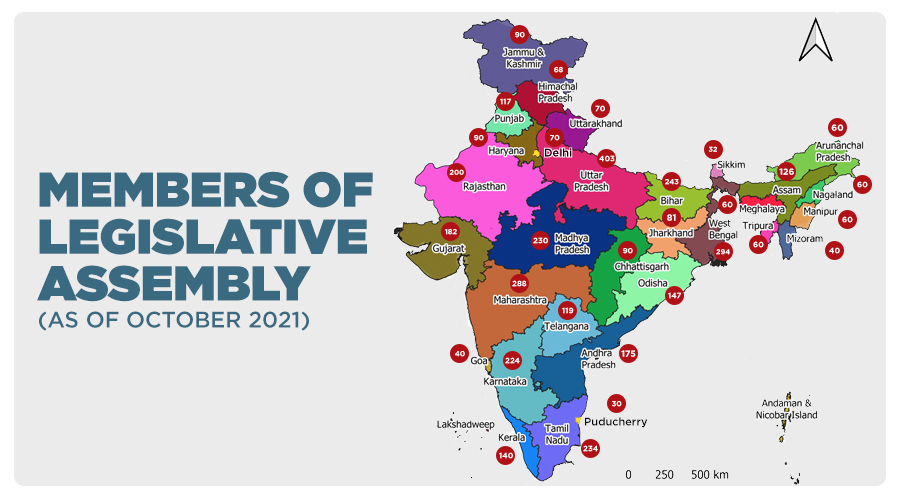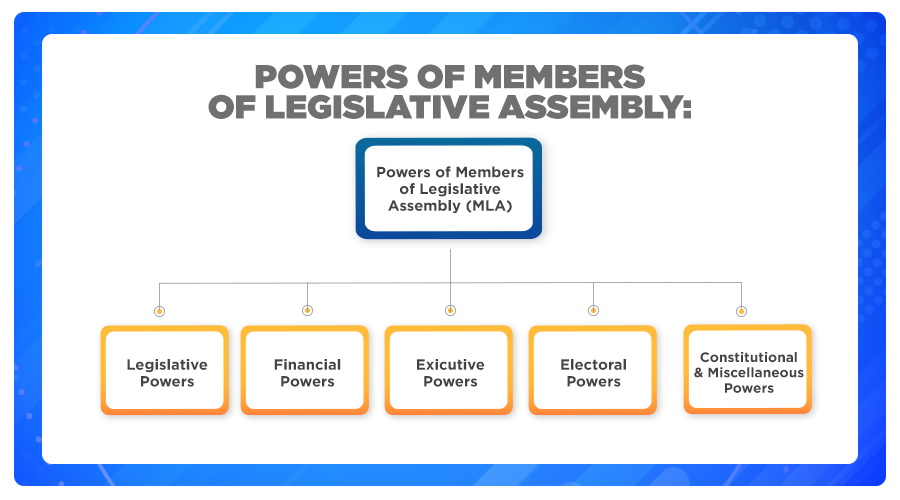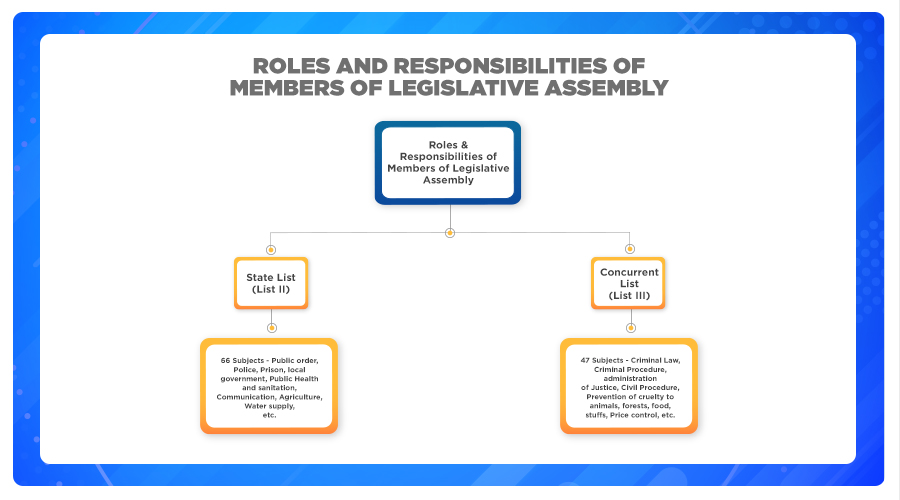What do you think is the role of a Member of the Legislative Assembly (MLA)?
The role of an MLA has not always been clearly understood. The only idea or misconception that most people have is, an MLA resolves civic concerns like waste management, supply of water, treatment of sewage and construction of roads.
An MLA’s role is a lot more than just this, but before we learn about that, let’s understand a little more about MLAs.
A Member of the Legislative Assembly (MLA) is a representative elected by the voting citizens of a constituency. They are elected to the legislature of the State Government. From each constituency, people elect one representative who becomes a member of the legislative assembly. Each state in India has anywhere between seven to nine MLAs for every Member of the Parliament (MP) in the Lok Sabha. The Constitution of India states that a State Legislative Assembly can have no less than 60 members and no more than 500 members. This applies to all Indian states except for states like Goa, Sikkim, Mizoram and Puducherry, which have less than 60 members.
Not many know that only a Member of the Legislative Assembly can work as a minister for more than six months. If a non-member of the Legislative Assembly becomes a Chief Minister or a minister, he must become an MLA within six months to continue in the job. Only a Member of the Legislative Assembly can become a Speaker of the Legislature.
Qualification of A Member of the Legislative Assembly:
The qualifications of members of the state legislature are similar to the qualifications of the members of parliament. A Member of the Legislative Assembly should fulfil the following:
- They must be a citizen of India.
- They must have completed the age of 25 years.
- They must not hold an office of profit.
- They must possess qualifications laid down by the Parliament of India.
- They must not be of unsound mind and should not have been disqualified by a competent court.
- No person can become a member of the Legislative Assembly or the Legislative Council of any state unless the individual is a voter from any state’s constituency. Those who cannot become members of Parliament also cannot become members of the state legislature.
- The person should not be convicted of any offence or sentenced to imprisonment of 2 years or more.
The standard term of the Legislative Assembly is five years. In India, the average salary and allowances of the Members of Legislative Assembly differ from one state to another. As per the government rules and regulations, the salaries of state MLAs are decided by their particular state legislatures.
As of October 2021, India has a total of 4,123 Members of the Legislative Assembly, with bifurcations for each state being as follows:

The Powers of Members of Legislative Assembly:
The powers of MLAs can be classified as legislative, financial, executive, electoral and constitutional.

- Legislative Powers
According to the Constitution of India, Members of the Legislative Assembly have powers to frame laws on all items in the state list and the concurrent list. Some aspects under these lists include police, prison, irrigation, agriculture, local governments, public health, pilgrimages, burial grounds, etc. Some items on which both Parliament and states can make laws are education, marriage and divorce, forests, protection of wild animals and birds.
- Financial Powers
A money bill can originate in the Legislative Assembly, and the Members of the Legislative Assembly must give consent for any expenses made from the State Treasury. All grants and tax-raising proposals must be authorized by the Members of the Legislative Assembly for them to be executed and implemented for the development of the state.
- Executive Powers
The Members of the Legislative Assembly in each state exercise certain executive powers. They control the activities and actions taken by the Chief Minister and the Council of Ministers. The ruling government is answerable to the Legislative Assembly for all its decisions. A vote of no-confidence can be passed only by the Members of the Legislative Assembly in any state. The Members of the Legislative Assembly can exercise Question Hour, Cut Motions, and Adjournment Motions to restrict the state government’s executive organ.
- Electoral Powers
The elected Members of the Legislative Assembly comprise the Electoral College, which elects the President of the country. The Members of the Legislative Assembly elect the members of the Rajya Sabha. They also elect the speaker and deputy speaker of the legislative assembly. In states like Andhra Pradesh, Bihar, Karnataka, Maharashtra, Telangana, and Uttar Pradesh, which have a bicameral legislature (a legislature that consists of two chambers or houses), one-third of the members of the Legislative Council are elected by the Members of the Legislative Assembly.
- Constitutional and Miscellaneous Powers
Parts of the Indian constitution that relate to federal provisions can be amended by ratification by one-half of the Members of the Legislative Assembly. The Members of the Legislative Assembly review reports of the Accountant General and the Public Service Commission. They also appoint the various committees to the House
Roles and Responsibilities of the Members of Legislative Assembly:

According to the constitution of India, Members of the Legislative Assembly have powers to frame laws on all items in:
- State List (List II)
The State List specifies 66 subjects on which each State Legislature can decide, and such laws operate within the territory of each state. The main subjects of the State List are public order, police, state court fees, prisons, local government, public health and sanitation, hospitals and dispensaries, pilgrimages within India, intoxicating liquors, relief of disabled and unemployable, libraries, communications, agriculture, animal husbandry, water supply, irrigation and canals, fisheries, road passenger tax and goods tax, capitation tax and others.
- Concurrent List (List III)
The Concurrent List consists of 47 subjects. The Union Parliament and the State Legislatures have the power to legislate over the subjects listed in List III (Concurrent List). The main subjects listed in this list are criminal law, criminal procedure, preventive detention for reasons concerned with the security of the state, marriage and divorce, transfer of property other than agricultural land, contract, actionable wrongs, bankruptcy and insolvency, trust and trustees, administration of justice, evidence and oaths, civil procedure, contempt of court, lunacy, prevention of cruelty to animals, forests, protection of wild animals and birds, population control and family planning, trade unions, education, labour welfare, inland shipping and navigation, price control, stamp duties, and others.
Members of the Legislative Assembly in Bengaluru:
Karnataka is one of the bicameral legislatures in India. The state legislature consists of two houses, the Vidhana Sabha (lower house) and the Vidhana Parishad (upper house). The state is divided into 224 constituencies.

The different areas in Bengaluru are clubbed together to form different zones like
-
- Bengaluru South: This comprises areas like Vijay Nagar, Srinagar, Basavanagudi, BTM Layout, J.P. Nagar, etc.
- Bengaluru West: This comprises areas like Aramane Nagar, Mathikere, Malleshwaram, Gandhi Nagar, Chickpet, etc.
- Bengaluru East: This consists of areas like Sanjay Nagar, Hebbal, Banaswadi, Lingarajapuram, CV Raman Nagar, etc.
- Rajarajeshwari Nagar: This zone consists of areas like Jalahalli, Kengeri, Laggere, Rajarajeshwari Nagar, Hemmigepura, etc.
- Mahadevpura: This zone has areas like Horamavu, Ramamurthy Nagar, Hudi, KR Puram, Kadugodi, etc.
- Dasarahalli: This zone has areas like Shettihalli, Mallasandra, Rajagopala Nagar, Peenya Industrial Area, Chokkasandra, etc.
- Yelahanka: This zone is made up of areas like Attur, Vidyaranyapura, Jakkur, Thanisandra, Kodigehalli, etc.
- Bommanahalli: This zone comprises areas like HSR Layout, Bommanahalli, Begur, Gottigere, Bilekahalli, etc.
Although not a part of the Bengaluru metropolitan area, areas like Attibele, Anekal, Thavarekere, Jigani, Nelamangala, Hesaraghatta, etc. are also considered to be a part of Bengaluru. A Member of the Legislative Assembly handles one or more areas in a given zone.
The Members of the Legislative Assembly in Bengaluru perform all the roles and responsibilities listed in the State List and Concurrent List. Here’s a list of Members of the Legislative Assembly in Bengaluru, as collated by B.PAC and details about their contact.
The roles and responsibilities of a Member of the Legislative Assembly are vast and covers many areas. Members of the Legislative Assembly divide their time between their constituencies and their work in the Assembly. They are responsible for the even and efficient functioning of the State Assembly, and as citizens, it is essential for us to know and understand these, to assist in the smooth governance of the state.





